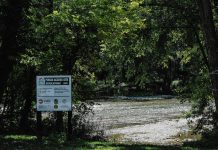For the second time in four weeks, a group of Duke Energy employees from Columbus has been sent to North Carolina to help hurricane victims.
After leaving Thursday morning, Duke Energy operations superintendent Sam Mills, scheduler Michael Smith and lineman Nathan Wheeles were scheduled to arrive late that night in North Carolina to begin repairing power outages caused by Hurricane Michael.
The trio are among 600 Duke Energy professionals from Indiana, Ohio and Kentucky working to restore electricity to about 433,000 homes and businesses in the Carolinas, said Chip Orben, government and community relations manager for the utility’s Columbus office.
The Carolinas have suffered more than their share of dangerous or devastating weather in the past few years. Disastrous floods swamped South Carolina in 2015, followed by the arrival of Hurricane Matthew in the fall of 2016. About a month after Hurricane Florence arrived for the Labor Day weekend this year, Michael made landfall Wednesday in the Florida Panhandle and began moving north.
[sc:text-divider text-divider-title=”Story continues below gallery” ]Click here to purchase photos from this gallery
Power-restoration teams are often expected to work 16-hour days, seven days a week, while they are assigned to disaster areas, Orben said.
Before leaving Bartholomew County, Mills, Smith and Wheeles were told to pack enough clothes and supplies for two weeks, Orben said. They were also told to anticipate more devastation than what was caused in the same region by Florence last month, he said.
Compared to Florence, which had a top wind speed of 137 miles per hour, Michael was packing wind speeds up to 155 mph, according to news accounts.
“From our perspective, wind is worse than rain because it can take out trees and man-made structures that cause us substantially more damage,” Orben said.
Last weekend, Columbus-based Duke linemen Tom B. Wetherald and Randy Wagner returned from North Carolina after spending almost three weeks assisting victims of Florence.
After being teamed with other Duke Energy linemen from Aurora and Connersville, the two men from Columbus helped restore power to residents in New Bern and Bridgeton, North Carolina.
“We saw a lot of flooding, and the smell of stagnant water was out of this world,” Wetherald said. “But we did not see many broken utility poles. Just downed lines.”
In contrast with the coastal towns hit by Florence last month, Michael took a different track by heading up west-central areas of both North and South Carolina. After making landfall in the Florida panhandle on Wednesday, the storm began drenching mid-state cities and mountain towns in Georgia, the Carolinas, and finally southeast Virginia before it began heading back out to sea.
The fact that so many utility poles along this track were broken leads Wetherald to believe Mills, Smith and Wheeles will have to face challenges in the weeks ahead.
“It could be really bad for them,” Wetherald said.
But luckily, the leader of Duke’s crew is no novice at these sort of things. This is the ninth trip to a storm-damaged area for supervisor Sam Mills.
During his 26 years working for the utility, Mills has been sent to help victims of Hurricane Irma in 2017, Hurricane Sandy in 2012, and Hurricane Katrina in 2005.
It’s not just tropical storms that Mills is skilled at handling. He has also been sent on winter trips to the Detroit area twice to help restore power after massive ice storms.
While the Hurricane Michael crew has their work cut out for them, Wetherald predicts they will also discover there are no better nor grateful people in the world than those in North Carolina.
“As soon as they get the power on, our crews can expect to see pies, cookies and coffee coming their way,” Wetherald said.
[sc:pullout-title pullout-title=”What’s inside” ][sc:pullout-text-begin]
Latest impacts from Hurricane Michael, Page A6.
[sc:pullout-text-end]




